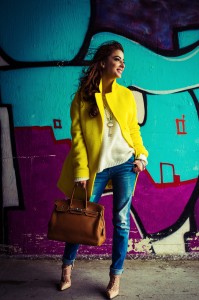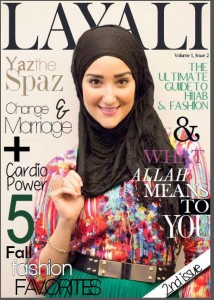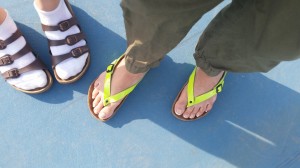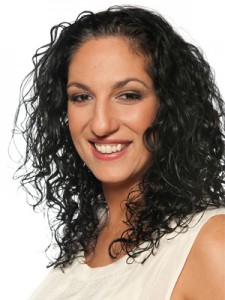For those of us Muslimahs engaged on any social media platform, we’re constantly inundated with beautiful pictures or videos of the latest in modest fashion. Flowy skirts or beautifully brightly coloured short dresses paired with tights; terrific footwear and fabulous headcoverings or styled tresses. All accompanied by fabulous vintage accessories, statement necklaces and designer sunglasses.
Most of the time I am awed by the creativity and the effort of what is Modest Fashion.

My own small commitment to fashion is buying coloured hijabs (I am terrified of prints), and my go-to is colour-blocking. I have been sporting Birkenstocks since I was twelve and have no plans to change that. Before I started wearing hijab in university, I walked around in a messy-bun and had my long hair up most of the time. My fashion regimen is fairly simple. If I do make-up, it takes four minutes.
I have a bestie, Nabila (currently living in London), who is my fashion guru. She is a full-time PhD candidate but moonlights as a fashion blogger, and is the person to whom I refer for questions and ensemble approval (Whatsapp zindabad).
My interest and fascination in Hijab-Couture is not a reflection of me being jealous. Really, it is not. I have become very comfortable with myself and with Nabila’s constant affirmation can finally pick my own pedicure colours.
Nor is it a theological critique of the entire concept of hijab fashion. There is incessant debate on the issue, as explored in this recent video by Zujaja Creations.
Modest fashion is a billion-dollar industry and has even gained tremendous attention in mainstream media and in academic circles. And just like any other faction of the worldwide industry, it has its challenges.
There are discussions about male power dynamics in in fashion, creative controls and objectification of Muslimahs, brilliantly covered by Laila in a recent MMW post. MMW’s Izzie wrote a wonderful critique of some major fashion bloggers and the pressures of keeping up with “the hijab-tutorial celebrities.” She argues that videos and posts by hijab-fashion bloggers often have the same negative effects that as their non-Muslim counterparts, creating fixations with celebrities and how they look.
Choosing to wear hijab isn’t supposed to create more stress on women, and nor is it the climax of our spirituality.
In every area of fashion, we see constant depictions of fair and thin models, which propels fat-shaming and even shadeism – and modest fashion seems to have similar problems. It could seem that the concept of Islamic fashion might provide women with opportunities to partake in fashion trends while creating a niche for many women who chose to cover. However, it might not be that easy.

The hijab-fashion industry has its fair share of troubles as well. Recently, the last-minute cancellation of a fashion showcase morphed from one of the most highly anticipated events in Muslimah fashion into an outright scandal. Vendors lost money and many, many were bitterly disappointed in these ventures. The organizer fled the scene and was not reachable and was later investigated for fraud. The participants were stuck in Hershey, Pennsylvania, their hotel rooms cancelled and their merchandise unsold. Interestingly, what did emerge was a sense of community that helped sisters navigate through this debacle.
On a positive side, the extremely successful Sisters in Stilettos event in Toronto attracted many women who enjoyed the bazaar. The fashion show was hosted by one of Modest Fashion’s most recognized faces and “hijab-tutorial celebrity”: Yaz The Spaz.
All this loveliness aside, there are deeper aspects of modest fashion that plague me.
On April 23, 2013 over 1000 Bangladeshi factory workers were killed in a factory collapse as they stitched clothing for such labels as GAP, H&M, George (WalMart) and JOE Fresh (Loblaws Inc.).
Does ethical fashion play a role in the decision or influence modest fashion at all? Do the women who write and share their ideas or help draw attention to any larger issues? As Muslims isn’t there an obligation to promote fairness and justice in what we wear?
I interviewed a few fashion bloggers and their responses were honest. Both Saira and Ikhlas admitted to not exclusively using items that were from ethical-trade or sustainable fashion outlets. But for both, price was the most important variable to take into consideration, in order to ensure that many women could achieve certain looks.
In an interview, Ikhlas told me: “when shopping for myself, price does play an important role and so when recommending outfits or clothes to my readers, I aim for affordable pieces.” So buyer-economics do factor in, particularly when the main demographic of women following these bloggers is teens and 20 somethings.
Interestingly, both women define themselves as activists, as opposed to businesswomen, within the realm of fashion. Saira explained that “Initially it started out as a hobby turned into a business turned into a form of activism. Despite the financial return, there is honestly no bigger reward or better feeling than a reader telling me that a post of mine – or something I said really resonated with her.”
But are the modest fashion looks that some of these blogs promote really affordable? Are they viable for most women? I checked through many, many fashion blogs and did see designer handbags. I wondered about a few of the pricetags and Googled a classic Chanel purse that retails anywhere from $2000 and higher. I was horrified and perplexed as to how people reconcile such lavish pricetags.
I discussed this with Nabila, who gave me a different point of view:
“Don’t buy ‘throw- away’ clothes. We’ve all gotten in the habit of buying things we will wear only a few times. So even if you aren’t buying ethical conscious clothing- for whatever reasons- at least don’t buy stuff that you will throw away that creates more waste. It takes more savvy and knowing what style is rather than being a slave to fashion trends.”
It is not uncommon for Muslim fashion to turn towards ideas of high-end items. In fact, the most desirable hijab in the world is from Turkish fashion house Armine. Their hijabs start at $80 dollars a piece. And the founder is keen that the name Armine might perhaps rival Armani one day.

Cheaper than a Hermes scarf though, right? And we are supporting Muslims…RIGHT?
Truth be told, I can’t claim to be innocent. My often considered-ugly yet brilliantly comfortable Birkenstocks are expensive. In fact, they cost upwards of $120. And I justify this by telling myself that it is a requirement for my flat foot especially after all the sports. And I have a prescription from a Chiropodist.
Still, the issues surrounding ethical fashion – both when it comes to the conditions in which our clothes and accessories are made and when it comes to whether the fashion promoted on these blogs is really accessible for the women the blogs are marketed to – are floating around in my brain. Is there any representation of justice in fashion in our community?
I didn’t have to look far to find a community activist whose entire business centers around fair trade and ethical fashion. My friend Fizza Mir spearheads the Azadi Project with her friend Farah Ali.
Fizza’s perspective on fashion is different than most. She creates garments that are beautifully made and that also provide meaning opportunities for Bangladeshi women to curb the move to urban slums, something indicative of the exploitation in the fashion industry. Fizza and Farah both want to be aware of where their designs are being created and they insist they do not haggle with the producers and that they pay them the asking price for merchandise. Azadi Project strictly works with co-operatives that respects the workers, provide a living wage and safe working environments. But Fizza rejects certain labels.
“I don’t consider myself a “fashionista” by any means, in fact, for me that term conjures up all kinds of negative connotations with respect to over consumption, waste and exploitation. But I do love design, craft, creativity and fabrics; clothing is often the most immediate expression of all those things and it naturally gets lumped into the broader term “fashion.” This is where I get conflicted, because I do love “fashion” but I also know that ethically and environmentally, it’s an ugly industry.”
Azadi Projects lets us merge creativity and love of fashion and beautiful things with activism and support of honourable practices.
One thing most of the women I interviewed have in common was a respect for vintage and second-hand clothing. As Saira told me, frequenting vintage stores could also come at a hefty price, but it is possible to find one-of-a-kind items as opposed to mass-produced pieces. Originality and vision are a large part of fashion. Fizza agreed and added that in addition to the avoidance of putting all those clothes to landfills or shipping them to be disposed of overseas, you can find unique second-hand pieces that can be easily updated with buttons and slight adjustments.
The women I spoke to all have a similar flair for putting together a fabulous outfit. They might come from different perspectives but their dedication to their craft is obvious.
Ikhlas is proud of her “passion for fashion”. While she was growing up, she struggled with trying to find clothes that were modest, and it became even more difficult when she started wearing hijab. Her blog often posts suggestions where to find items that Muslimahs can add to their wardrobes.
All of the above-mentioned blogs come with complete pictures of outfits and style ideas which can be tapered to match someone’s own style preference. All this fashion isn’t always paisley and pearls.
Saira told me there is pressure to stay current and keep up with current trends. But she dictates her own fashion styles and frequent postings. Competition can be tough.
Ikhlas said that her critiques are often that she is either too conservative or too liberal — which leads me to believe she is probably doing something right.
Fizza’s challenge is getting the public to understand that ethical fashion is as much part of our responsibility as Muslims as modesty. She believes that we are not thinking past the exterior representations of what it means to be a Muslim with respect to upholding fairness and justice in all our transactions. But, she is hopeful that it can be done.
Part 2 of my investigation into ethical fashion for Muslim women will include a more extensive discussion with Fizza about concepts of sustainable fashion and how it should be understood and applied in Muslim communities. Working towards buying merchandise and understanding the challenges around buying items that might affect already marginalized people is consistent with our Islamic beliefs.
Muslim women are adding vibrancy to the fashion scene and I may not understand all of it but I appreciate their passion and different perspectives.
I look forward to watching the industry grow — from the sidelines.
*changes back into track pants*











